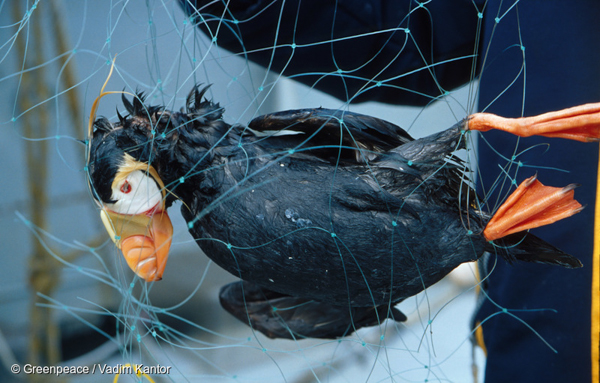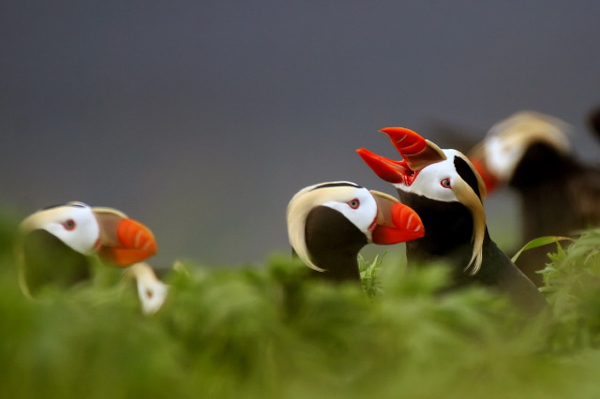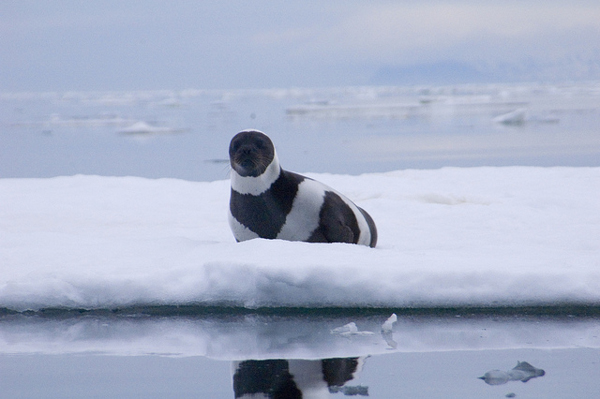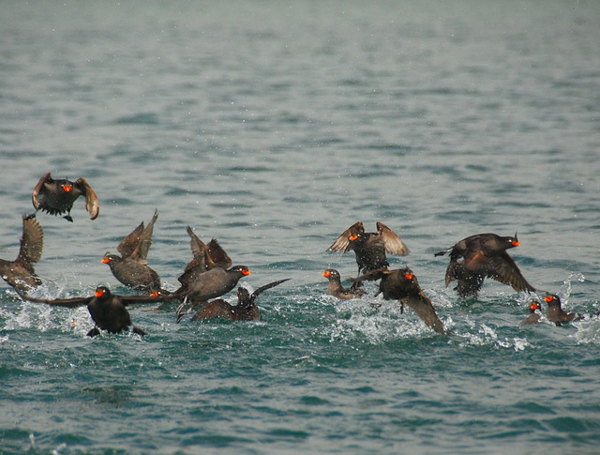News
Russia bans driftnet fishing, a reprieve for seabirds and marine mammals

On July 1, President Vladimir Putin signed a bill into law banning driftnet fishing in Russian waters.
Driftnets, floating walls of net that are nearly invisible underwater, can be 12 meters high and many kilometers long. They are a kind of gillnet, a mesh that captures fish by the gills, and are primarily used to target large schools of fish. But driftnets are notorious for trapping unintended marine life, including porpoises, dolphins, sea turtles, and an estimated 400,000 seabirds around the world each year, according to the conservation group Birdlife International. Their use has been banned or restricted in many countries territorial waters, and was banned on the high seas in 1992.
In Russia, driftnets are used by Russian and Japanese fishers to capture salmon in the country’s Far East. The ban was reportedly intended in part to make more fish available to Russia’s coastal salmon fishermen, who employ other fishing methods but whose catches have dropped as a result of driftnetting. It will take effect in January, 2016.

Tufted puffins in the Alaska Maritime National Wildlife Refuge. The species is commonly caught in driftnet salmon fishing gear in the waters off Russia’s far eastern shore. Photo credit: Steve Ebbert, USFWS.
BirdLife International estimates that 140,000 seabirds become trapped and die in driftnets each year in the region, the highest toll of any region globally. Heavily hit species include tufted puffins (Fratercula cirrhata), short-tailed shearwaters (Ardenna tenuirostris), thick-billed murres (Uria lomvia), and crested auklets (Aethia cristatella).
Marine mammals that will benefit from the ban include strikingly marked Dall’s porpoises (Phocoenoides dalli) and ribbon seals (Histriophoca fasciata), as well as Pacific white-sided dolphins (Lagenorhynchus obliquidens), according to the group.

An adult male ribbon seal in eastern Russia’s Ozernoy Gulf. Ribbon seals and other marine mammals can become entangled and drown in driftnet fishing gear. Photo credit: Michael Cameron, NOAA/NMFS/AKFSC/NMML.
“The banning of these huge nets in Russian waters is fantastic for an array of wildlife in the northwest Pacific and we support the closure of a fishery with such severe collateral damage to marine wildlife,” said Cleo Small, Head of BirdLife’s Marine Programme, in a statement.
 Thick-billed murres, another seabird species often caught in driftnet salmon-fishing gear in Russia waters. Photo credit: Josh Keaton, NOAA/NMFS/AKRO/SFD. |
Other environmental advocates are hailing the ban, as well. “The ban on driftnet fishingl [sic] is a big win for anyone who cares about the conservation of birds, salmon and porpoises in the Russian Far East,” Sergey Korostelev, the Marine Program Coordinator of WWF’s Kamchatka Bering Sea Ecoregional Office, said in a statement. The group has advocated for such a ban for many years.
The ban has reportedly strained relations between Russia and Japan, whose fishermen, particularly from the northern island of Hokkaido, have fished salmon with driftnets in Russian waters since the 1990s.
Japan’s Chief Cabinet Secretary Yoshihide Suga stated last week at a press conference that the law “gives rise to the utmost regret,” according to The Moscow Times. It and other outlets have reported that the ban will cost Japan $200 million.

Crested Auklets in Russia’s Kuril Islands. Photo credit: Austronesian Expeditions.
Article by Rebecca Kessler. Republished courtesy of Mongabay.org.
Blogs
Get ready for the Marine Conservation Society’s annual Great British Beach Clean this month

The programme is one of the largest marine citizen science activities of its kind in the UK. Volunteers taking part will not only be clearing our beaches of litter, but help the Marine Conservation Society, the UK’s leading ocean membership charity, to gather vital data to create change for cleaner and healthier seas.
This year’s Great British Beach Clean is being sponsored by Ireland’s leading soup brand, Cully & Sully Soup, whose support is helping to raise awareness of marine litter and protect UK beaches from pollution.
To sign up for a beach clean, or organise your own, simply visit the charity’s website.

Key stats and facts
- At last year’s Great British Beach Clean, 5,416 volunteers conducted 428 beach cleans over 10 days, surveying 64,139 metres of coastline. A total of 129,391 pieces of litter were collected, filling 1,426 bags and weighing 7,476 kg.
- The Marine Conservation Society has recorded an average drop of 80% in carrier bags found on UK beaches since charges were introduced, showing that policies to reduce plastic work.
- Data collected during the Great British Beach Clean contributes toward the charity’s annual State of our Beaches report. Last year’s report recorded a 14% increase in drinks-related litter.
- The report also showed that nine out of 10 beach litter items found on beaches by Marine Conservation Society volunteers last year were made from plastic.
- Sewage plays a large part in the pollution problem. In 2023, over 29,500 sewage-related items, including more than 21,000 wet wipes, were recorded across the UK and Channel Islands, with sewage-related items present on 72% of surveyed beaches.
- Data from the Marine Conservation Society’s Great British Beach Clean contributes to a global database, International Coastal Cleanup.
Key messages:
- Data collected by volunteers during the Great British Beach Clean shows the positive result of policies like carrier bag charges, and how they work to reduce litter on our beaches.
- Plastic still remains the most common form of beach pollution – highlighting the urgent need for further action to tackle the single-use plastic problem such as charges, bans and deposit return schemes.
- The Marine Conservation Society is calling for governments across the UK implement world-class deposit return schemes for drinks containers including glass, plastic, and cans, without any further delay. Currently the proposed scheme is set to start in October 2027, but with Wales being the only country to include glass.
- The charity hopes that the recent bans on single-use plastics, such as cutlery, will lead to a noticeable reduction in the amount of single-use plastic cutlery polluting our beaches, much like the positive impact of the carrier bag charge.
- Sewage-related pollution, such as period products and wet wipes, are still prevalent on our beaches. Governments of the UK must turn the tide on pollution and end untreated sewage damaging our marine environment.
- You can support the charity by helping to clean up the UK’s beaches and collecting valuable data that supports efforts to address sewage pollution effectively.
ON THE DEPOSIT RETURN SCHEME:
Lizzie Price, Beachwatch Manager at the Marine Conservation Society: “It’s fantastic to see real-world evidence of the effectiveness of policies such as carrier bag charges in tackling pollution from single-use plastics. There’s no denying that these measures have helped to reduce litter on our beaches. However, we cannot afford to become complacent.
“Drinks-related litter, such as bottles and cans, were found on 97% of UK beaches surveyed last year. We need wider policies such as charges, bans, or deposits on more single-use items where possible, including the proposed deposit return schemes for plastic bottles, cans, and glass. We must keep moving towards a society that repairs, reuses, and recycles.”
ON SEWAGE POLLUTION:
Rachel Wyatt, the Marine Conservation Society’s Water Quality Policy & Advocacy Manager:
“Our seas cannot sustain the deluge of sewage that is being dumped into our waterways on a weekly basis. Our beach clean volunteers find thousands of sewage-related litter items washed up on the beaches every year, but it’s not just physical pollution that is harmful to us and marine life. Raw sewage contains a cocktail of bacteria, viruses, harmful chemicals, and microplastics which is a disaster for our ocean. Governments of the UK must turn the tide on pollution and end untreated sewage damaging our marine environment, so that we can all enjoy sewage-free seas.”

ON VOLUNTEERING:
Clare Trotman, Beachwatch Officer at the Marine Conservation Society, said: “The work we do at the Marine Conservation Society simply wouldn’t be possible without the dedication of our volunteers, who help gather crucial beach litter data. This information is invaluable in shaping scientific understanding and driving the changes needed to protect our precious marine environment.
“With beach cleans taking place all over the UK and Channel Islands, there are countless opportunities to get involved and support us this year. And if you can’t make it to the beach, you can still contribute by organising a local litter pick and survey in your area.”
Cully Allen from Great British Beach Clean sponsor, Cully & Sully Soup, said: “We are excited to be part of the UK’s biggest beach clean initiative for a third year. As a B Corp, doing good is at the core of what we do. We are always striving to do better internally as a business, but we really enjoy when we get to encourage and join our customers in doing good. We are looking forward to getting stuck into the beach cleans again this year, serving up our soup to the SOUPer volunteers and taking direct action on marine litter.”

The following beach cleans are currently set to take place:
| Date | Region | County | Beach & link |
| 20/09/2024 | Weston-Super-Mare | North Somerset, England | Uphill Beach |
| 20/09/2024 | Wirral | Cheshire, England | West Kirby Beach |
| 21/09/2024 | Weston-Super-Mare | North Somerset, England | Sand Bay Beach |
| 21/09/2024 | Cramond | Edinburgh, Scotland | Cramond Beach |
| 21/09/2024 | Aberdeen | Aberdeenshire, Scotland | Aberdeen City Beach |
| 22/09/2024 | Formby | Merseyside, England | Formby Beach |
| 23/09/2024 | Portsmouth | Hampshire, England | Southsea Beach |
| 25/09/2024 | Littlehampton | West Sussex, England | Littlehampton East Beach |
| 27/09/2024 | Swansea | Glamorgan, Wales | Swansea Beach |
| 27/09/2024 | Portstewart | Londonderry, N. Ireland | Portstewart Beach |
| 27/09/2024 | Cleethorpes | Lincolnshire, England | Cleethorpes Beach |
| 27/09/2024 | Brixham | Devon, England | St Mary’s Beach |
| 28/09/2024 | Rhoscolyn | Isle of Anglesey, Wales | Borth Wen Beach |
| 28/09/2024 | Charmouth | Dorset, England | Charmouth Beach |
| 29/09/2024 | Wallasey | Merseyside, England | New Brighton Beach |
Find more information about the Marine Conservation Society at www.mcsuk.org.
News
Magdelena Bay: Experience the Mexican Sardine Run this November with Indigo Safaris

November 3 to 10, 2024 – aboard the Gallant Lady
October 19 to 26, 2025 – aboard the Nautilus Explorer
The Experience
From October to January, an extraordinary event unfolds in the nutrient-rich, vibrant blue waters off Magdalena Bay, where striped marlin gather to hunt during the second-largest sardine run in the world. This breathtaking underwater spectacle is one you won’t want to miss.
Set sail aboard the Nautilus Gallant Lady as we cruise along the stunning Baja California coastline. Our destination? The tranquil waters and outer islands of Magdalena Bay, where massive schools of sardines congregate. Each fall, an oceanic upwelling merges with warm waters, creating ideal conditions for these sardines in the shallow, cobalt-blue waters. These waters teem with life, featuring bait balls and predators such as seabirds, blue and mako sharks, sea lions, whales, dolphins, wahoo, and the fastest fish in the ocean—the striped marlin. With speeds reaching 50 mph (80 km/h), it’s a thrilling experience to be in the water next to a bait ball, watching marlin zoom past with their dorsal fins fully extended. You might also encounter pelicans, gulls, booby birds, frigate birds, shearwaters, and even the majestic albatross.
Trip Highlights
- Witness one of the world’s largest sardine hunts in Magdalena Bay
- Snorkel alongside striped marlin as they prepare for a feeding frenzy
- Chance to see California sea lions, dolphins, wahoo, and more
- Spot humpback whales and, if lucky, possibly orcas or blue whales
- Scuba dive the SS Independence and a WWI submarine wreck
- View pelicans, gulls, booby birds, frigates, shearwaters, and albatross
Pricing
November 3 to 10, 2024 on Gallant Lady
- Superior Suites: $3,670 USD per person (tax included) – 0 spots left
- Premium Suite: $4,195 USD per person (tax included) – 1 spot left
- $35 USD port fee (paid onboard)
October 19 to 26, 2025 on Nautilus Explorer
- 1 Triple room berth: $3,355 USD – 1 spot left
- 2 Single Suites: $4,455 USD – 2 spots left
- 2 Superior Suites: $3,775 USD per person (tax included) – 4 spots left
- 1 Standard Suite: $3,564 USD per person (tax included) – 4 spots left
- $35 USD port fee (paid onboard)
Inclusions
- Accommodation
- All meals: continental breakfast, breakfast, lunch, dinner, and dessert
- Non-alcoholic beverages and snacks
- Daily room service
- Towels and onboard facilities (including hot tub and lounge)
- Lots of fun!
Exclusions
- Airport transfer
- Bar and gift shop purchases
- Crew gratuities
- Internet access
- $35 USD port fee
Photography Coaching
Underwater photography coaching will be provided by Christopher Bartlett, the founder of Indigo Safaris and an experienced underwater photographer. Christopher’s work has been featured globally, and he has published over 100 articles on diving and marine conservation. His photography has appeared on numerous dive magazine covers. During the trip, Christopher will offer photography guidance, from basic to advanced lighting techniques for macro and wide-angle shots. He’ll help you set up your gear and process your images in Lightroom. Christopher has been leading Cetacean trips since 2015 and has extensive experience with species like sperm whales, humpbacks, sharks, sea lions, dolphins, and bait balls.
The Journey
Embark on the luxurious 116 ft, six-cabin expedition yacht, Nautilus Gallant Lady, and follow this remarkable migration across the Sea of Cortez. Whether you’re a snorkeler, swimmer, or diver, this trip caters to all experience levels. We’ll ensure you get ample time in the water with schools of mobula rays. Some encounters may last just minutes, while others could extend for over an hour—and sometimes, the rays may even welcome you into the middle of their formation. A bonus experience? Special night encounters with rays as they gather around our dive lights in shallow, protected bays.
Who is this trip for?
This adventure is perfect for both divers and snorkelers. While there are a couple of dive days, non-divers can enjoy the action through snorkeling. Most of the bait ball excitement is best experienced while snorkeling.
Day 1
Arrive at SeeCreatures Cabo by 4:30 pm. After boarding, we’ll set sail along the stunning Baja California coastline, heading toward the sheltered waters and outer islands of Magdalena Bay, home to the famous sardine run.
Day 2
Kick off the adventure with three dives at the southern end of Margarita Island, where you’ll explore sites that include playful sea lions and the remains of a steamship that sank in the early 1900s.
Days 3 – 6
It’s time to hunt for bait balls and jump into the water with striped marlin! This eco-tourism experience is a collaboration with local pangas and expert captains. Captain G and his family and friends are masters at locating bait balls, giving you the best chance for marlin encounters. Spend as much or as little time on the water as you like—the more time you invest, the more striped marlin sightings you’ll enjoy. Scuba diving is also a core part of the itinerary.
Magdalena Bay teems with life at this time of year. Alongside marlin, you could see whales, dolphins, turtles, sharks, and sea lions. Don’t miss the chance to explore the nearby mangroves and stunning sand dunes. For added adventure, kayaks and stand-up paddleboards (SUPs) will be available for your use.
Day 7
On the final day at Magdalena Bay, we’ll wrap up with three more dives, including a dive at the wreck of a WWI submarine and another sea lion encounter.
Day 8
Disembark at SeeCreatures Cabo after enjoying a final breakfast at 8:30 am.
The Vessel
Accommodating 12 passengers in six spacious suites, the Gallant Lady offers a luxurious and comfortable experience. The cabins are split between the lower and main decks, featuring five Superior Suites and one Premium Suite. Each suite is equipped with individually controlled air conditioning, a California king or two double beds, ample storage, and private en-suite bathrooms.
Superior Suites – Inde, Dofleini, Rosario, Nautilus & Swell
Two Superior Suites are located on the main deck, while the remaining three are on the lower deck. Four of these suites can be configured with either a California king bed or two double beds. Each suite includes a private en-suite bathroom with a shower and individually controlled A/C.
Premium Suite – Emerald
The spacious Premium Suite, located on the lower deck, offers flexibility with either a California king bed or two doubles. It also features a private en-suite bathroom with a full-sized bathtub.
Social Spaces
The Gallant Lady is designed with several comfortable social areas to help you unwind. The sky lounge on the top deck, complete with a hot tub, is the perfect spot to enjoy a cocktail after a day of adventure. Relax between dives on the sundeck, or take in the wrap-around views from the main salon and dining room, which also boasts a fully stocked bar.
The onboard chef prepares a delicious fusion of Mexican and West Coast North American cuisine, and all dietary requirements can be accommodated with advance notice.
For more information or to book, contact Indigo Safaris:
Email: safariexperts@indigosafaris.com
UK: +44 771 334 27 29
USA: +1 718 312 8777
France: +33 668 74 97 05
Skype: christopherbartlett
-

 Blogs1 month ago
Blogs1 month agoGozo: An Underwater Treasure Trove in the Heart of the Mediterranean
-

 News3 months ago
News3 months agoMurex Bangka Announce New Oceanfront Cottages & Beachfront Dining
-

 Gear Reviews2 months ago
Gear Reviews2 months agoGear Review: Scubapro Luna 2 AI Dive Computer
-

 Marine Life & Conservation3 months ago
Marine Life & Conservation3 months agoIceland issue millionaire whale hunter a licence to murder 128 vulnerable fin whales
-

 Blogs2 months ago
Blogs2 months agoMamma Mia! Diving Skopelos (Part 1)
-

 News2 months ago
News2 months agoDived Up release NEW Second Edition of Diving Gozo & Comino by Richard Salter
-

 Marine Life & Conservation3 months ago
Marine Life & Conservation3 months agoSHARK MONTH ARRIVES AT ROYAL WILLIAM YARD, PLYMOUTH
-

 Blogs2 months ago
Blogs2 months agoAlonissos: The complete diving destination (Part 1)


















